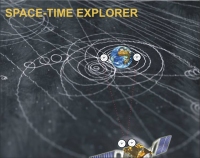Space-Time Explorer (STE)
 |
Einstein's theory of general relativity is a metric theory, where gravity is the result of curves in space-time induced by the presence of mass. The theory is highly successful in describing gravitational interactions and to date has proven capable of satisfactorily explaining observations from within our Solar System out to the Universe at large. However, experiments continue to be performed with an increasingly higher accuracy to test if the theory is correct.
A cornerstone of Einstein's theory of gravity and one of the pillars of modern physics is Einstein's equivalence principle (EEP), according to which the local effects of a gravitational field are the same as those introduced by being in an accelerated reference frame. The EEP comprises three elements:
- The outcome of any local non-gravitational experiment is independent of the velocity of the freely-falling reference frame in which the experiment is performed (local Lorentz invariance).
- The outcome of any non-gravitational experiment is independent of where or when in the Universe it is performed (local position invariance). This also implies that the fundamental constants of non-gravitational physics do not vary with time.
- The trajectory of a freely falling test particle in a gravitational field, when not affected by any other force, is independent of the particle's internal structure and composition. This is equivalent with the statement that a particle's inertial mass (resistance to acceleration) is equal to its gravitational mass (its weight), which is known as the weak equivalence principle.
Science Goals of STE
The main goal of the Space-Time Explorer would be to search for violations of the EEP and at the same time challenging general relativity and alternative theories of gravitation. The measurement concept of the STE mission is based on space-to-ground comparisons of high-performance microwave clocks (atomic clocks). High-performance clocks in space allow tests of EEP to accuracy levels not achievable solely on ground.
STE would perform a precision measurement of gravitational red shift in the gravitational potentials of the Earth and the Sun with a relative accuracy at the level of
Gravitational red shift (GRS) measurements are specifically suited for testing the Local Position Invariance. GRS is a gravitational effect that can be observed with clocks, which are predicted to run slower when they are deeper inside a gravitational potential. How much slower should be solely dependent on the gravitational potential at the clock's position, if EEP is valid. The GRS measurements by STE would challenge Einstein's prediction, and test metric theories of gravitation.
A highly elliptical orbit (baseline: apogee ~50 000 km, perigee ~700 km) has been selected for the STE spacecraft. The large variations of the Earth's gravitational potential along the orbit are important to maximize the relative accuracy of the red shift measurement.
In addition, as the Earth orbits the Sun, measurements made over the course of the STE mission lifetime would allow measuring the gravitational red shift at different points in the Sun's gravitational field.
Testing the gravitational red shift and its universality would be the primary science goal of the STE mission. The secondary science goals of STE would include:
-
Test of local Lorentz invariance.
The space-to-ground comparison of atomic clocks as foreseen for STE would also allow testing the isotropy and constancy of the light velocity providing direct tests of special relativity and the local Lorentz invariance, which is part of the EEP. -
Test of the time invariance of fundamental constants.
High-performance clocks in space allow establishing a global network for the comparison of atomic clocks on ground, worldwide to high performance levels (frequency uncertainty better than10-18 ). Based on the ground-to-ground comparison of atomic clocks of fundamentally different types and over an extended period allows testing the constancy of fundamental physical constants. -
Relativistic geodesy.
Possibility to perform differential measurement of the Earth's gravitational potential via a differential red shift measurement between two clocks on ground. Using clocks of accuracy10-18 on ground, potential differences could be measured with an equivalent height resolution of 1 cm.
The tentative baseline STE mission is for a single spacecraft carrying a caesium atomic clock. To compare the on-board atomic clock with atomic clocks on the ground, the STE spacecraft would employ a microwave link with six science ground stations. The baseline mission would have a two-way triple-frequency link, which allows for accurate determination and removal of the ionospheric effects on the signal, reaching high stabilities in the space-to-ground comparison of clocks. Alongside the microwave link, a coherent optical link is also included in the baseline, offering high link stability and redundancy. In addition the satellite would carry a "corner cube" for spacecraft ranging and for time tagging, as well as a global navigation satellite system (GNSS) receiver for accurate orbit determination.
Assessment study
The CDF assessment study of the STE mission concept ran from 15 June to 16 July 2010. The internal final presentation of the STE assessment study, prepared by the STE/CDF team, is now available in PDF format. The document can be retrieved through the link in the right-hand menu under "related publications".
